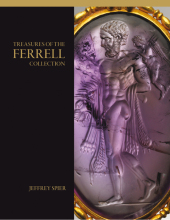 Neuerscheinungen 2010Stand: 2020-01-07 |
Schnellsuche
ISBN/Stichwort/Autor
|
Herderstraße 10
10625 Berlin
Tel.: 030 315 714 16
Fax 030 315 714 14
info@buchspektrum.de |

Jeffrey Spier
Treasures of the Ferrell Collection
2010. 340 p. w. 391 col. figs. 31 cm
Verlag/Jahr: REICHERT 2010
ISBN: 3-89500-795-1 (3895007951)
Neue ISBN: 978-3-89500-795-8 (9783895007958)
Preis und Lieferzeit: Bitte klicken
"Die hinsichtlich einiger Objekte von den Vorschlägen des Verf. abweichende Meinung des Rez. (...) vermögen den hohen Wert des Kataloges keineswegs zu schmälern. Die einzelnen Texte enthalten konzise Beschreibungen und nachvollziehbare Datierungen. Verbunden mit dem wissenschaftlichen Apparat und den Abbildungen, die durchgängig von hervorragender Qualität sind, stellt die vorliegende Publikation eine gelungene Erschließung dieser vorzüglichen Sammlung dar. Der im Vorwort formulierte Anspruch geschmackvollen Genusses wurde ohne Zweifel eingelöst, für einige Objekte wird man sich zudem wünschen, dass sie dauerhaften Eingang in den wissenschaftlichen Diskurs finden. Der vorliegende
Katalog bildet dafür zweifellos einen wichtigen Ausgangspunkt, für dessen Existenz man Sammler und Verf. gerne seinen Dank abstattet."
Jörn Lang
In: Göttinger Forum für Altertumswissenschaft 14 (2011) 1187-1194
JUli 2012)
James Ferrell has collected Greek and Roman antiquities for many years to satisfy his life-long interest in ancient history. His collection is particularly important for its focus on jewelry, engraved gems and cameos, imperial medallions, and silver plate dating from the end of the Roman Empire and the early Byzantine period (3rd-7th centuries AD). It was at this time that the Roman Empire was gradually overrun by barbarian invaders and shifted its capital eastward, to the newly founded city of Constantinople.
The Ferrell Collection is particularly rich in objects made of precious metal created in royal and imperial workshops, ranging from jewelry of the Hellenistic Greek kings to medallions and brooches presented by the Roman emperors to high officials and military officers. Also included are beautifully made objects from Gothic craftsmen of the fifth and sixth centuries, including gold and silver buckles and jewelry inlaid with garnets. The catalogue continues with a superb assemblage of Byzantine jewelry and an important selection of sixth-century ecclesiastical silver vessels.
Jeffrey Spier is a university associate and adjunct professor in the Classics Department at the University of Arizona. He has published extensively on Greek and Roman gems and jewelry and on early Christian and Byzantine art. His books include "Ancient Gems and Finger Rings. Catalogue of the Collections, The J. Paul Getty Museum" (1992), "Late Antique and Early Christian Gems" (2007), and "Picturing the Bible: the Earliest Christian Art" (2007).
This volume publishes over 200 works of art belonging to the American collector, James Ferrell. The focus of the collection is on jewelry, engraved gems and cameos, medallions, and silver plates primarily of the late Roman and early Byzantine periods (3rd-7th centuries AD). Much of the material derives from imperial workshops and served as official gifts.
The catalogue opens with a small selection of Hellenistic jewelry, including a group composed of a necklace, earrings, and rings probably of Ptolemaic origin. The second chapter is composed primarily of late Roman jewelry, gems and cameos, and other objects in precious metal, including necklaces, bracelets, rings, fibulae, and belts, most of which date between the third and fifth centuries AD. The third and fourth chapters are devoted to the jewelry and other objects found in Gothic tombs of the fifth and sixth centuries AD. Chapter Five presents an outstanding selection of Byzantine jewelry of the sixth and seventh century, including pendants, crosses, bracelets, earrings, and rings, many set with precious gems and pearls. The final chapter is devoted to Byzantine ecclesiastical silver of the sixth century AD.
The publication will be of considerable interest to a variety of scholars, museums, and collectors. Historians of late antiquity will find many objects with important imperial associations. The rich selection of Byzantine jewelry and silver, including many pieces decorated with unusual iconography, will be of importance to Byzantinists. The Gothic objects include many pieces of particularly high quality. Jewelry historians and collectors will be delighted with the superb color photography.


